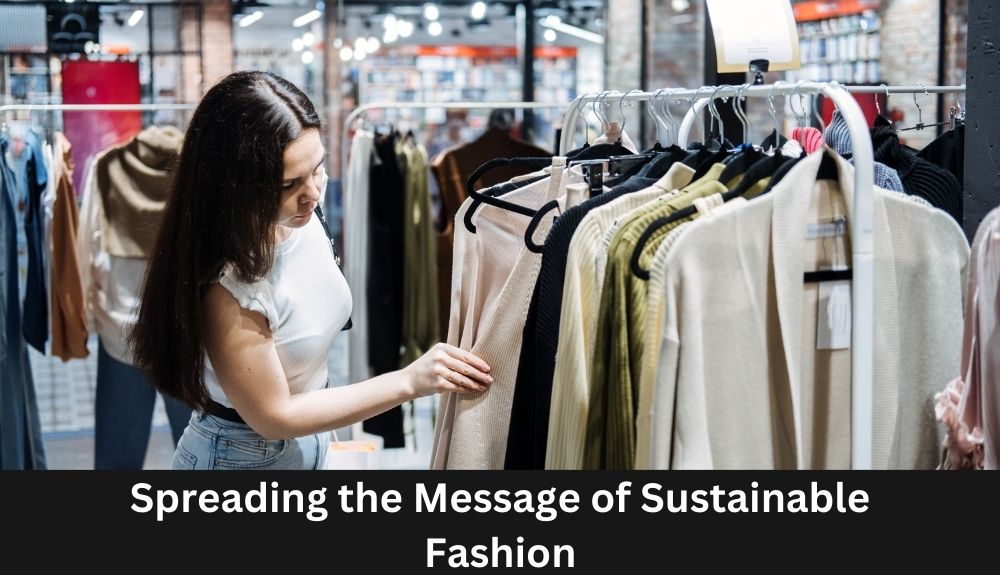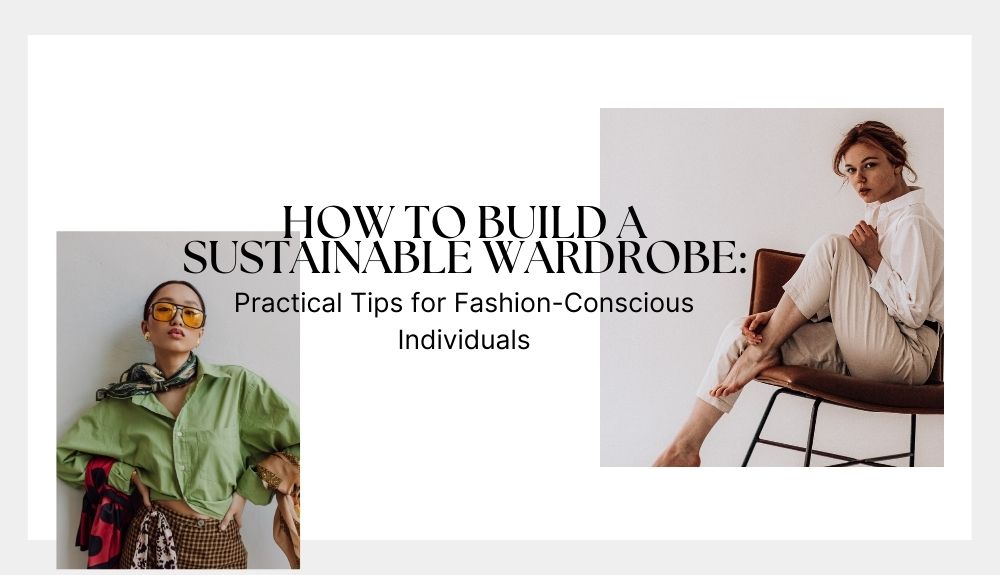How to Build a Sustainable Wardrobe: Practical Tips for Fashion-Conscious Individuals
Are you a fashion-conscious individual looking to make a positive impact on the environment? Building a sustainable wardrobe is not only trendy but also essential for conscious consumers like yourself. By embracing ethical fashion choices and reducing your carbon footprint, you can contribute to a more sustainable future.
In this blog, we will provide you with practical tips and insights on how to build a sustainable wardrobe. From conscious consumption and ethical brands to eco-friendly materials and responsible fashion practices, we’ve got you covered. Take a step towards reducing waste and embracing sustainable options in your fashion choices.
– Discover the benefits of shopping at thrift stores and the joy of finding unique pieces.
– Learn about eco-friendly materials like organic cotton and their positive impact on the environment.
– Explore ethical brands that prioritize fair trade and sustainable practices.
– Find out how investing in high-quality garments can save you money in the long run.
– Dive into the world of upcycling and discover creative ways to breathe new life into your clothes.
Join us on this sustainable fashion journey and learn how to create a stylish wardrobe that aligns with your values. Make small choices that can have a big impact on the fashion industry and the planet. Let’s make a difference together!
Introduction to Building a Sustainable Wardrobe
In today’s fast-paced world, building a sustainable wardrobe goes beyond just following the latest fashion trends. It’s about making conscious choices that have a positive impact on the environment and society. By embracing ethical fashion practices and adopting a mindset of conscious consumption, individuals can reduce their carbon footprint and contribute to a more sustainable future.
Conscious consumption involves being aware of the social and environmental impact of the fashion industry. It means making informed decisions about what we buy and wearing clothes that align with our values. By prioritizing quality over quantity, we can shift away from the throwaway culture and invest in garments that are made to last.
Ethical fashion choices play a vital role in building a sustainable wardrobe. This means supporting brands that prioritize fair labor practices and have transparent supply chains. By choosing sustainable materials such as organic cotton or eco-friendly fabrics, we can minimize the environmental impact of our clothing choices.
Building a sustainable wardrobe is not just a personal choice, but a collective responsibility. It’s about making small yet impactful changes that collectively make a difference. So, whether you’re a fashion-conscious individual or someone new to the sustainable fashion journey, this guide will provide you with practical tips and insights to help you build a stylish and sustainable wardrobe that reflects your values and makes a positive impact.
Remember, each purchase we make has the power to shape the future of the fashion industry. By embracing conscious consumption and ethical fashion choices, we can be a part of a movement that transforms the way we view and engage with fashion.
Educate Yourself and Embrace Slow Fashion
To build a sustainable wardrobe, it’s crucial to educate yourself about sustainable fashion practices and embrace the concept of slow fashion. By adopting a mindset of quality over quantity, you can make conscious choices that have a positive impact on the environment and the fashion industry.
Here are some tips to help you educate yourself and embrace slow fashion:
1. Research Sustainable Practices and Brands
Take the time to research and learn about sustainable fashion practices, such as the use of eco-friendly materials, ethical labor practices, and the reduction of waste in the production process. Look for brands that prioritize sustainability and transparency in their supply chains.
2. Follow Sustainable Fashion Influencers
Follow influencers and experts in the sustainable fashion industry on social media platforms. They often share valuable insights, tips, and recommendations for conscious consumerism. By staying informed, you can make more informed choices about the brands you support and the garments you purchase.
3. Attend Sustainability Workshops and Events
Participate in workshops, seminars, and events focused on sustainability in the fashion industry. These gatherings provide opportunities to learn from industry leaders, discover innovative solutions, and connect with like-minded individuals. By attending these events, you can gain a deeper understanding of sustainable fashion practices and stay up-to-date with the latest trends and initiatives.
4. Embrace Second-Hand Shopping and Clothing Swaps
Explore thrift stores, consignment shops, and online platforms that offer pre-loved clothing. Second-hand shopping allows you to give new life to gently used garments and reduces the demand for fast fashion. Additionally, consider participating in clothing swaps with friends or in local communities to refresh your wardrobe without contributing to waste.
5. Practice Mindful Consumption
Instead of succumbing to trends and impulse purchases, take a thoughtful approach to your fashion choices. Before buying a new item, consider its quality, versatility, and longevity. Look for timeless pieces that can be worn in various styles and for different occasions. By investing in higher-quality garments, you not only reduce your need for frequent replacements but also support the idea of responsible wardrobe building.
Remember, building a sustainable wardrobe is a journey, and embracing slow fashion is an essential aspect. By educating yourself and making conscious choices, you can reduce your carbon footprint, support ethical practices, and contribute to a more sustainable future in the fashion industry.
Thrift and Second-Hand Shopping
Thrift and second-hand shopping offer an excellent opportunity to find unique and sustainable pieces for your wardrobe while reducing textile waste and promoting a circular fashion economy. Here are some of the key benefits of embracing thrift and second-hand shopping:
1. Affordable and Budget-Friendly Options
Thrift stores and second-hand shops often offer clothing and accessories at a fraction of the original retail price. By shopping second-hand, you can find high-quality items without breaking the bank. This allows you to build a sustainable wardrobe on a budget and allocate your savings towards more conscious fashion choices.
2. Unique and Vintage Finds
One of the most exciting aspects of thrift and second-hand shopping is the possibility of discovering unique and vintage pieces. These items often carry a sense of history and individuality, allowing you to express your personal style in an authentic way. By incorporating vintage garments into your wardrobe, you also contribute to the preservation of fashion heritage.
3. Environmental Benefits
By choosing second-hand clothing, you actively participate in reducing textile waste and the environmental impact of the fashion industry. Every garment purchased from a thrift store means one less item ending up in a landfill. Additionally, the production of new clothing involves significant resources, such as water, energy, and raw materials. Opting for second-hand items helps to minimize the carbon footprint associated with the manufacturing process.
4. Supporting Charitable Causes
Thrift stores often support various charitable organizations or local communities. When you shop at these establishments, your purchases contribute to their meaningful work. By supporting thrift and second-hand shops, you can make a positive impact beyond just your own fashion choices.
In conclusion, thrift and second-hand shopping offer multiple benefits for building a sustainable wardrobe. From affordability and unique finds to environmental conservation and charitable support, embracing second-hand options allows you to make conscious and ethical fashion choices. So, next time you’re looking to update your wardrobe, consider exploring the treasure trove of thrift stores and second-hand shops.
Supporting Ethical Brands
In today’s fashion landscape, supporting ethical brands is crucial for building a sustainable wardrobe. By making responsible fashion choices, you can contribute to positive change in the industry and reduce your carbon footprint. Here are some key reasons why supporting ethical fashion brands matters:
Environmental Impact
Ethical fashion brands prioritize sustainability throughout their supply chains. They use eco-friendly materials like organic cotton, recycled fabrics, and innovative fibers made from renewable resources. By opting for sustainable materials, these brands minimize their environmental impact and promote the preservation of our planet.
Ethical Labor Practices
One of the pillars of ethical fashion is ensuring fair and safe working conditions for garment workers. Ethical brands prioritize transparency and make sure their manufacturing processes align with ethical labor standards. By supporting these brands, you can play a part in combating the exploitation often associated with fast fashion.
Positive Social Impact
Ethical fashion brands often partner with local communities and artisans, fostering economic growth and supporting traditional craftsmanship around the world. By purchasing their products, you are empowering these communities and contributing to a more inclusive and equitable fashion industry.
Quality and Longevity
Ethical brands emphasize quality over quantity, creating garments that are made to last. By investing in higher-quality clothing, you reduce the need for frequent replacements, leading to less waste and a more sustainable wardrobe. These pieces are timeless, versatile, and can be worn for various occasions, making them excellent long-term investments.
Conscious Consumerism
Supporting ethical brands is a way to practice conscious consumerism. It involves considering the overall impact of our fashion choices and making deliberate decisions that align with our values. By choosing ethical brands, you send a powerful message to the fashion industry that sustainability is a priority.
Remember, every purchase you make is an opportunity to support brands that align with your values and contribute to a more sustainable future. By supporting ethical fashion brands, you can make a positive impact and build a wardrobe that is both stylish and responsible.
By selecting ethical fashion brands, you can support sustainability, fair labor practices, positive social impact, and conscious consumerism. Take the opportunity to make a positive change in the fashion industry and build a wardrobe that aligns with your values.
Mindful Disposal and Garment Care
Proper disposal of unwanted garments and taking care of your clothes are crucial steps in building a sustainable wardrobe. By implementing mindful practices, you can extend the lifespan of your garments and reduce the environmental impact. Here are some tips to help you in this process:
Donate or Recycle
When you no longer need or want a garment, consider donating it to a thrift store, charitable organization, or clothing swap event. This way, someone else can give it a new life. Alternatively, if the garment is no longer wearable, check if there are textile recycling facilities in your area. Recycling textiles helps minimize waste and reduces the strain on landfill sites.
Repurpose and Upcycle
Get creative and find new uses for your old clothes. Repurposing can be as simple as turning worn-out t-shirts into cleaning rags or transforming them into trendy tote bags. Additionally, consider upcycling garments by altering or embellishing them to create unique pieces that suit your style. This not only reduces waste but also adds a personal touch to your wardrobe.
Proper Garment Care
Taking care of your clothes ensures they last longer and reduces the need for frequent replacements. Here are some tips to help you maintain your garments:
– Follow the care instructions on garment labels.
– Wash your clothes in cold water to save energy and preserve the fabric.
– Line-dry your clothes whenever possible to minimize energy consumption.
– Mend any small damages, such as loose buttons or seams, to extend the lifespan of your garments.
– Store your clothes properly, using hangers or folding them neatly, to prevent wrinkles and maintain their shape.
Remember, proper disposal and garment care contribute to reducing fashion waste and the overall environmental impact of the fashion industry. By implementing these practices, you play a vital role in building a sustainable wardrobe and making a positive impact on the planet.
Continue to embrace sustainable fashion practices as we move towards a more eco-conscious and responsible approach to dressing.
Exploring Rental and Sharing Economy
One of the most sustainable alternatives to fast fashion is the concept of renting and sharing clothes. In recent years, the rental and sharing economy has gained popularity as people recognize the environmental benefits and cost-savings of this approach. By embracing this trend, you can make a positive impact on the fashion industry and reduce your own carbon footprint.
The Benefits of Renting and Sharing Clothes
1. Sustainability: Renting or sharing clothes significantly reduces the demand for new garments to be produced, leading to a reduced environmental impact. It promotes the circular economy by extending the lifespan of clothing items.
2. Affordability: Renting clothes is a cost-effective way to enjoy a wide variety of stylish outfits without the need to purchase each item. It allows you to wear special occasion garments without the guilt of one-time use.
3. Experimentation: Renting gives you the opportunity to try out different styles, trends, and designer pieces that you may not typically invest in. It allows you to step out of your fashion comfort zone without the commitment.
4. Convenience: Renting clothes eliminates the need for storage space and the hassle of cleaning and maintaining a large wardrobe. You can effortlessly switch up your style by renting new items whenever you want.
How to Participate in the Rental and Sharing Economy
1. Online Platforms: Numerous online platforms cater to the rental and sharing economy, such as Rent the Runway and Le Tote. These platforms offer a wide selection of garments for various occasions, from casual wear to formal attire.
2. Local Communities: Check out local clothing rental services, clothing swaps, or fashion exchange events in your area. These community-based initiatives provide a more personalized and sustainable approach to borrowing and sharing clothes.
3. Fashion Subscription Boxes: Subscription-based services like Gwynnie Bee and Haverdash offer curated clothing collections that you can rent and enjoy for a specific period. This option allows you to regularly update your wardrobe without the hassle of shopping.
In conclusion, exploring the rental and sharing economy within the fashion industry is an excellent way to embrace sustainability and reduce the negative impact of fast fashion. By renting clothes, you contribute to a circular economy, enjoy affordability and experimentation, and make a positive difference in the fashion world. Join the movement and become a conscious consumer who understands the value and benefits of sharing and renting clothes.
Spreading the Message of Sustainable Fashion

As fashion-conscious individuals, it’s not only important for us to build our own sustainable wardrobe, but to also educate and inspire others about the significance of sustainable fashion. By spreading awareness and encouraging conscious choices, we can collectively make a positive impact on the environment and the fashion industry as a whole.
Here are some effective ways to spread the message of sustainable fashion:
1. Social Media Engagement
Take advantage of the power of social media to showcase your sustainable fashion choices and educate your followers. Share outfit inspiration, tips on eco-friendly materials, and information about ethical brands. Use hashtags like #sustainablefashion and #ethicalclothing to reach a wider audience and connect with like-minded individuals.
2. Organize Clothing Swaps
Host or participate in clothing swap events within your community. This allows people to exchange clothing they no longer wear, reducing waste and giving garments a new lease on life. By organizing these swaps, you can introduce others to the concept of sustainable fashion and show them how easy it is to refresh their wardrobe without harming the environment.
3. Support Local Markets and Sustainable Fashion Events
Attend local markets and sustainable fashion events in your area. These gatherings often bring together eco-conscious designers and brands, providing an opportunity to learn more about their practices and discover unique, responsibly-made pieces. By supporting these events, you contribute to the growth of the sustainable fashion industry and encourage others to do the same.
4. Share Informative Content
Whether through your own blog, guest posts, or contributions to relevant publications, share informative content about sustainable fashion. Write about the positive impact of better fibers, the importance of ethical labor practices, or tips for building a sustainable wardrobe. By providing accurate and valuable information, you empower readers to make informed choices and become advocates for sustainable fashion.
5. Be a Role Model
Lead by example and let your sustainable fashion choices speak for themselves. People often look up to those they admire, so by showcasing a well-made fashion brand or wearing a responsibly-made basic, you can inspire others to follow suit. Be open to discussing your fashion choices and share why sustainability matters to you. Use your influence to make a positive difference in the fashion industry.
Remember, by spreading the message of sustainable fashion, we can create a ripple effect that encourages others to join us on this important journey towards a more ethical and environmentally-friendly wardrobe. Let’s inspire change and make sustainable fashion the new norm.
Investing in Quality Pieces
Investing in high-quality garments is a crucial aspect of building a sustainable wardrobe. Not only does it contribute to reducing waste, but it also ensures that you have pieces that are durable and timeless. Here are some reasons why investing in quality pieces is essential:
1. Longevity and Durability
Unlike fast fashion items that are often made with inferior materials and construction, high-quality garments are designed to withstand the test of time. They are crafted with attention to detail, using sturdy stitching and superior fabrics. Investing in such pieces means you won’t have to constantly replace worn-out items, reducing your overall consumption and environmental impact.
2. Timeless Style
Quality pieces often feature timeless designs and classic silhouettes. Their versatility allows you to create various outfits for different occasions, eliminating the need for trend-driven clothing. By opting for timeless styles, you can build a wardrobe that transcends seasons and fashion cycles, ensuring longevity in both style and functionality.
3. Sustainable Materials
Many high-quality brands prioritize sustainability by utilizing eco-friendly materials. From organic cotton to sustainable fabrics derived from recycled fibers, these materials contribute to reducing the fashion industry’s environmental impact. By investing in garments made from such materials, you support responsible fashion practices and encourage the use of sustainable alternatives.
4. Ethical Labor Practices
Quality pieces often come from brands that prioritize ethical labor practices, ensuring fair wages and safe working conditions for their employees. By supporting these brands, you contribute to positive social impacts within the fashion industry, promoting better standards and empowering workers.
5. Cost-Effectiveness
While quality pieces may have a higher upfront cost, they are often more cost-effective in the long run. Their durability and longevity save you money by preventing frequent replacements. By making a proper investment in your wardrobe, you can curate a collection of garments that will provide years of use and enjoyment.
Investing in high-quality garments is not only a wise financial decision but also a conscious choice that aligns with sustainable fashion practices. By prioritizing longevity, timeless style, sustainable materials, ethical labor practices, and cost-effectiveness, you can build a wardrobe that makes a positive impact on both the environment and the fashion industry.
Remember, true style comes from quality and conscious choices. Choose well-made fashion brands that share your values and make a difference with each purchase.
Upcycling and Repurposing

Upcycling and repurposing old garments is a creative and sustainable way to give new life to your wardrobe. Instead of throwing away clothes that no longer fit or are out of style, consider transforming them into something unique and trendy. Here are some ideas and tips to get you started:
1. Denim Revamp
Turn old denim jeans into stylish shorts by cutting them to your desired length and adding a distressed look with sandpaper. You can also repurpose denim jackets by adding patches or embroidery for a personalized touch.
2. T-shirt Transformation
Transform oversized or outdated t-shirts into trendy crop tops by cutting them just above the waistline. You can also create stylish headbands, tote bags, or even pillowcases from old t-shirts.
3. Sweater Makeovers
If you have old sweaters with holes or worn-out sleeves, repurpose them into cozy scarves or hand warmers. You can also unravel the yarn and knit or crochet it into a new garment or accessory.
4. Accessory Upgrades
Add a pop of color to plain accessories by using fabric scraps to create fabric-covered earrings, hairpins, or brooches. You can also repurpose old belts as straps for bags or use them as jewelry organizers.
5. Patchwork Creations
Combine different fabric scraps to create unique patchwork designs on your garments. Whether it’s patchwork jeans, a patchwork jacket, or even a patchwork skirt, these one-of-a-kind pieces will showcase your creativity.
Remember, upcycling and repurposing require some basic sewing skills, but you can also find no-sew options using fabric glue or iron-on patches. Get inspired by browsing DIY fashion blogs, social media platforms, and online tutorials for more ideas and step-by-step instructions. By embracing upcycling and repurposing, you can reduce waste and contribute to a more sustainable fashion industry.
Conclusion: Building Your Ethical Wardrobe
In conclusion, building a sustainable wardrobe is not only a trendy choice but also an essential one for fashion-conscious individuals who want to make a positive impact. By following these practical tips, you can create a stylish and ethical wardrobe while reducing your carbon footprint:
1. Educate Yourself and Embrace Slow Fashion: Learn about sustainable fashion practices and shift towards quality over quantity.
2. Thrift and Second-Hand Shopping: Explore thrift stores and second-hand markets to find unique and sustainable pieces while giving pre-loved clothing a new life.
3. Supporting Ethical Brands: Choose to support ethical fashion brands that prioritize sustainability, fair trade, and ethical labor practices.
4. Mindful Disposal and Garment Care: Properly dispose of unwanted garments by donating, selling, or upcycling them. Also, adopt good garment care practices to extend the lifespan of clothes.
5. Exploring Rental and Sharing Economy: Consider renting clothes or participating in clothing swaps to reduce the demand for fast fashion and embrace a circular economy.
6. Spreading the Message of Sustainable Fashion: Share your knowledge and experiences with others to raise awareness and inspire them to make sustainable fashion choices.
7. Investing in Quality Pieces: Opt for higher-quality garments that are made to last, reducing the need for frequent replacements.
8. Upcycling and Repurposing: Get creative with DIY projects to transform old garments into new and unique items, giving them a second life.
Remember, every small choice you make in your fashion journey can have a positive impact on the environment and the fashion industry. Start making responsible wardrobe choices and be a part of the sustainable fashion movement.











